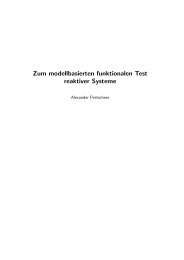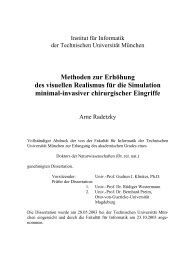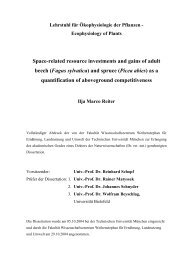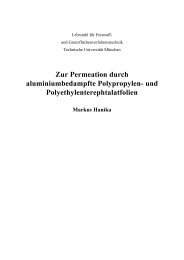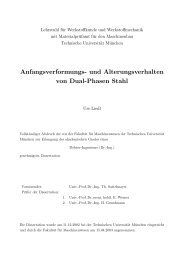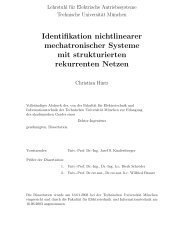Topologically Defined Neuronal Networks Controlled by Silicon Chips
Topologically Defined Neuronal Networks Controlled by Silicon Chips
Topologically Defined Neuronal Networks Controlled by Silicon Chips
You also want an ePaper? Increase the reach of your titles
YUMPU automatically turns print PDFs into web optimized ePapers that Google loves.
CHAPTER 2. NETWORKS OF DEFINED TOPOGRAPHY<br />
The topographic structures in this study consisted of pits with 70µm and 80µm diameter for taking up<br />
the cells and 14µm wide connecting grooves, see fig. 2.8A. Their overall height ranged from 10µm to<br />
40µm. Note the perfectly vertical walls shown in the inset, they are essential for controlling neuronal<br />
outgrowth and confining cells to the pits.<br />
Although a structure height of 10µm is sufficient to reliably guide growing neurites and retain them in<br />
the grown geometry, somata are sometimes pulled out of the pits, as they are too shallow, especially to<br />
confine large cell bodies. By increasing the resist thickness to 30µm-40µm even large somata are kept<br />
in place, but at the cost of a poor visibility of neurites at the bottom of the grooves. Diffraction at the<br />
edges of the groove walls diminishes optical resolution with increasing structure depth.<br />
This dilemma is elegantly solved <strong>by</strong> processing two resist layers on top of each other. A single thin<br />
layer for guiding neurites while not impairing visibility and two layers in areas surrounding the somata<br />
to provide enough force to keep them in place. The process is adapted from the single layer process, but<br />
slightly more complex. Its first steps, including the post exposure bake, are identical to those described<br />
above, but are then followed <strong>by</strong>: spin-on of second resist layer, softbake, bead removal, second exposure,<br />
post exposure bake, development and hardbake. As the first resist layer remains photosensitive in<br />
areas not illuminated in the first exposure, care must be taken that the second mask also protects them<br />
during the second exposure, otherwise the first pattern is overwritten <strong>by</strong> the second. This constraint<br />
limits the three-dimensional features that are accessible with the procedure, e.g. bridges and covered<br />
conduits cannot be made, as they require an exposed layer on top of unexposed areas, see [44] for a<br />
technique to build these structures. Fig. 2.8B depicts such a two layer device, again note the vertical<br />
walls and the perfectly aligned second layer.<br />
2.4 Theory part I: Neurons, synapses and cables<br />
Understanding the behavior of an entire neuronal network at the basic level requires profound knowledge<br />
about its building blocks, namely neuronal somata, neurites and synapses; a theory describing<br />
these building blocks is presented in this section.<br />
All neurons used throughout the study only form electrical synapses, which also transmit negative, hyperpolarizing<br />
signals; in contrast to chemical synapses. Because of this behavior the voltage-independent<br />
synaptic conductances can be determined with a passive model. The model implies that all parameters,<br />
such as synapse and membrane conductance, do not depend on the transmembrane voltage. These<br />
conditions can be experimentally realized best, when neurons are hyperpolarized. Based on these assumptions,<br />
subsection 2.4.1 and 2.4.2 present equivalent circuits and related equations for a single<br />
soma, a soma with neurites and small networks.<br />
More complex neuronal behavior, such as the generation of action potentials, can only be described<br />
with an active model including voltage-dependent conductances, as outlined in 2.4.3.<br />
2.4.1 Passive model and cable theory<br />
The isolated soma is the elementary unit of all neural networks. In a passive model its equivalent circuit<br />
is represented <strong>by</strong> a single, isopotential compartment with a capacitance Cs in parallel to an ohmic<br />
conductance Gs and a battery V0, see fig.2.9A. Cs and Gs are properties of the soma membrane (index<br />
s), the resting potential V0 is generated <strong>by</strong> different ionic concentrations between intra and extracellular<br />
space; for more details refer to subsection 2.4.3. A current Iinj injected into the cell via an electrode<br />
charges its capacitance and leaves through the membrane conductance. The dynamics of the somatic<br />
membrane voltage, Vs, of this circuit is described <strong>by</strong> the following differential equation:<br />
18<br />
dVs<br />
Iinj = Cs<br />
dt + Gs(Vs − V0) (2.1)


